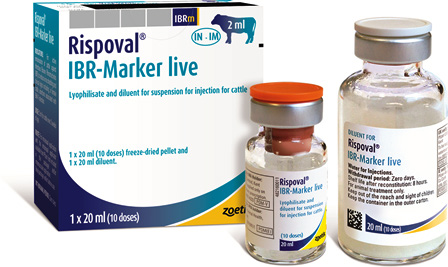Infectious bovine rhinotracheitis or IBR is a widespread disease with evidence of infection in the majority of Irish herds.
Whilst respiratory signs and abortion are generally well recognised as clinical features of IBR, the economic consequences of subclinical infection (without readily-observable symptoms) are often underestimated.
Depending on the average milk price, losses due to subclinical infection are estimated at up to €6,000/year for a 100-cow compact, spring-calving Irish dairy herd.
These losses are due to an average of 250L less milk/cow/year, as well as reduced milk fat and protein yields; and the cost of a clinical outbreak of IBR can be considerably higher.
To identify whether IBR is present in your herd, bulk-milk screening often provides a simple, cost-effective way for dairy herds, whereas blood sampling a representative cohort of animals in beef herds will provide information on the herd’s IBR-infection status.
Complete and regular herd vaccination is most commonly used to control the impact of IBR.
Vaccination of infected herds will make it less likely that animals will become infected and spread the virus in the first place. It will also reduce the risk of shedding from carriers that are already present in your herd.
In IBR-negative herds, vaccination will reduce the impact of virus introduction and the devastating problems this can lead to.
A simple and robust IBR vaccination programme
A simple and robust IBR vaccination programme consists of combining the use of live and inactivated vaccines for effective IBR disease control.
The programme involves giving all animals over the age of three months an initial dose of Rispoval IBR Marker live in July.
This is then followed by a single dose of Rispoval IBR Marker inactivated in December, which will then give protection for 12 months. A yearly booster with the inactivated vaccine will be needed for continued protection.
Vaccinating calves with Rispoval IBR Marker live in July when they are over three-months-of-age will reduce the chances of them becoming infected with IBR and becoming lifelong carriers in the first place, thus reducing the overall risk to your herd over time.
The convenience of carrying out whole-herd vaccination with Rispoval IBR Marker inactivated in December means your herd will be protected for 12 months and only requires yearly boosters, rather than six-monthly when only using live vaccines.
Also, when cows are vaccinated in early lactation (spring), they are less likely to produce an optimal response to the vaccine as most cows will be in negative energy balance and many will be suffering from immunosuppression or are potentially affected by postpartum diseases such as mastitis, metritis or ketosis.
Keep it simple and maximise IBR control in your herd by starting with the Rispoval IBR Marker live vaccination this summer. Click here for more information


